I struggled to establish a pace in the first mile of a 10K in Southern California last weekend. Sheets of rain poured down so hard that my vision blurred while my feet slipped or sank in dirt as thick and fertile as potting soil. A pack of guys led the way through a rough-cut path in a field edged by native shrubs and scraggly trees, on a trail wedged between a third-rate golf course, a river bed, a mushroom farm, and a homeless encampment.
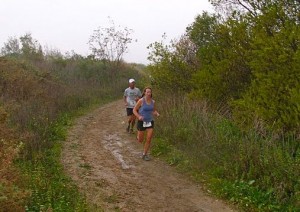
That's me in the European XC Challenge 10K in Ventura, California, on Jan. 30 (photo courtesy Compete Green).
Suddenly, a smell assaulted our senses—a stench of ammonia and compost, with a hint of sewage—as we rounded a turn by a giant pile of steaming, hay-filled manure. Then, as if to further connect me to my equestrian past, I encountered a wall of hay bale hurdles.
I have run many 10Ks but none quite like the European XC Challenge in Ventura, the inaugural event by an eco-conscious upstart company called Compete Green.
I did not know what to expect from a “European” cross-country event. Scones or biscotti at the finish line? “Pardon me, would you have any Grey Poupon?”
No, that’s not it at all. The race directors explained that the course, in the European tradition, would feature obstacles to jump or run through, such as fences, knee-high dirt mounds, mandatory mud puddles, and those hay bales.
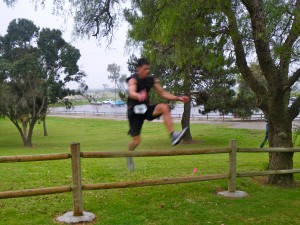
Jason Havelka clears the final fence before the finish line, one of several obstacles on the course.
Sure enough, I found myself hurdling as never before. Wha-hoo, I did it! The thrill of accomplishment—or at least, of not face-planting—began to answer the question I asked myself at the starting line, as a cloudburst drenched us all, Why am I here?
I signed up for two main reasons: First, to walk the talk (or better, run the talk) of this blog’s message to keep improving and to cultivate meaningful experiences as a runner by trying new things, exploring new destinations, and finding new routes in familiar places. I had to go to Ventura County for a meeting and decided to find a local race as part of my trip.
I grew up near Ventura, in the town of Ojai, and drove past the race course on Highway 101 dozens, perhaps hundreds, of times without stopping. The race gave me an excuse to explore the side roads and revisit the waterfront. I also discovered a historic site I didn’t know about, the Olivas Adobe hacienda from 1847, where the race started and finished.
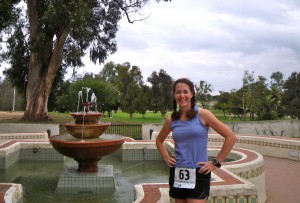
... and the Olivas Adobe park at the starting line the following morning (just before the rain started).
The second reason I signed up was to support the race organizers, Compete Green, and their mission to promote sustainability and eco-awareness through their events. Earlier in the week, I spent time considering the environmental consequences of our allegedly green sport after reading a thoughtful article by ultrarunner Dakota Jones, “The Oversized Footprint of Running,” published on iRunFar.com.
“We’re literally loving our wild places to death,” he wrote. “… Emissions from cars and planes add CO2 to the atmosphere while thousands of pounds of waste are generated through the disposal of countless thousands of gel packs. Inefficient aid stations feature single-use paper cups for small amounts of drinks and paper bowls for only a few servings of candy or fruit. Running shoes are commonly made from synthetic rubbers derived from petroleum products that take thousands of years to fully break down in landfills. And just about all clothing and gear in the sport is stitched or assembled in Asia—in factories whose power comes from coal-fired power plants—and then distributed worldwide on high-emissions vehicles. Even if we forget about all that, the ecosystems we run through are fragile, and the massive influx of people for races naturally degrades their unique characters. Running is commonly idealized as an environmentally low-impact sport, but the reality is that we pollute far more than we know.”
Here I am discarding all those foil gel packs, driving solo to trail heads, and advocating travel—guilty as charged.
I admire Compete Green’s sincere intent to make small but significant steps to host races in a way that minimizes trash, reduces resource use, and promotes carpooling or public transportation. More event organizers need to do their part in this way. But what I really liked was how co-director Ben DeWitt encouraged us runners to keep coming out and using the relatively new trails in the area that he helped clear. It might not sound particularly eco-friendly to make trails through open space, but to me it is when the land is threatened by future development. I agree fully with what one person wrote in response to Jones’s article: “Although it’s true that trail runners and trail events can leave a lot of unfortunate flotsam on the landscape, and the consumption that goes into our sport carries with it some nasty side effects, it’s also important to highlight the role our community should play in promoting open space. On balance, I think I’d rather have more people out on the trails (as long as they act responsibly), if that usage reinforces the value of the open space to local communities. Otherwise there are plenty of economic reasons to bulldoze every field.”
I didn’t dwell on all this serious stuff while plowing through the gummy soil and muddy puddles of the course. I ran as hard as my not-really-in-10K-shape body could manage and finished second among the women, third overall, in about 46 minutes. (It was a small field of only 24 runners; most participants did the 5K.)
But I thought about the environment afterward as I drove up the still-gorgeous California coast, offsetting a fraction of my guilt at the gas pump by refilling my water bottle rather than buying sparkling water in a plastic bottle. So here’s what I’m gonna do my best to do:
- Buy less stuff: Already doing this. Our whole family became less materialistic after experiencing a stripped-down lifestyle during long-term travel. See my singlet and shorts in the photo? They’re both four or fives years old, and I’ll wear them ’til they fall apart.
- Use less stuff: I’ve decided to stop using Vespa sport supplement. Its benefit seems marginal anyway, and it always bothered me how it comes in individual foil pouches with plastic screw tops. I don’t know if I can give up Gu or Hammer gel packs completely, but I can use fewer and get electrolytes and calories from less-wasteful sources. Our household also is trying to use less energy by using the dryer less and using a hand-push mower instead of gas-powered for the lawn.
- Re-use stuff: I reuse plastic bags, water bottles, etc., but can always try to reuse more.
- Recycle stuff: Our family is recycling more and buying some things used, like winter ski clothing. We need to be better about participating in running shoe recycling programs and buying shoes made from recycled materials.
- Carpool to running events and plan travel judiciously: Already planning to carpool to next weekend’s race.
- Eat lower on the food chain and be a locavore: I gave up beef and am trying not to buy out-of-season produce from halfway around the globe.
- Participate in events that promote open-space and other environmental causes: Compete Green has several coming up, such as the Ojai 2 Ocean Marathon in my hometown June 5 (wish I could run it!). I hope my Bay Area friends will join me March 19 at the Diablo Trails Challenge 50K/Half Marathon/10K/5K in support of one of our region’s best environmental groups, Save Mount Diablo.
There are no easy steps to significantly offset the environmental consequences of our recreation and travel. But if you have any ideas, please share them below.

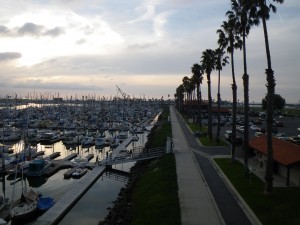
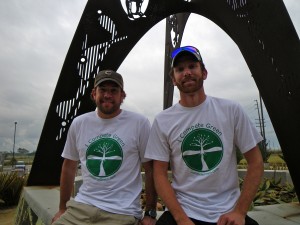
Sarah,
I really enjoyed your blog post. It thrills me that you met Tom and Ben, however even more so that you enjoyed the event. I believe wholeheartedly in their mission and will continue to support them – and keep my own foot mark as small as possible – as they grow. Thanks for sharing! Truly, Andi
Sarah,
It was great meeting you and thanks for taking that great picture! Since the European XC Challenge, I have been an avid visitor to your site, learning so much from your articles and experiences. It was nice meeting you and thanks for all the information. See you soon.
Jay